Thread types play a crucial role in various industries, from plumbing and gas fittings to mechanical assemblies. Each type of thread is designed with a specific geometry, standard, and application in mind, and selecting the right thread is essential for ensuring leak-proof, secure connections. Here, we’ll explore four common thread types: PT, NPT, G, and Metric threads.
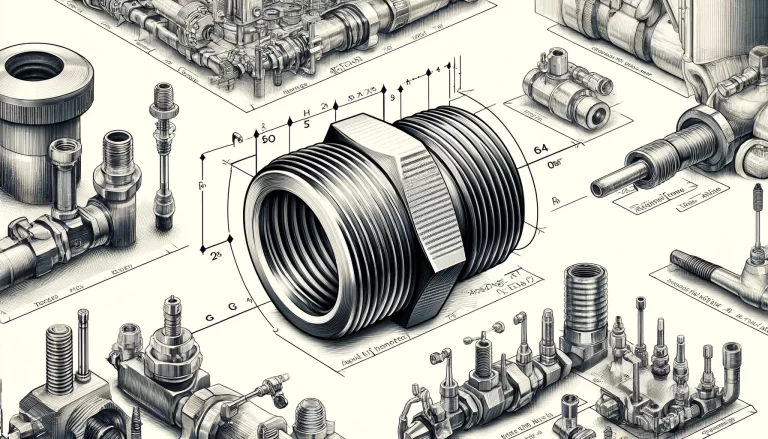
1. PT Thread (Japanese Standard Pipe Tapered Thread)
PT (Pipe Thread) is a standard pipe thread used predominantly in Japan and is regulated under the Japanese Industrial Standard (JIS). PT threads are widely used in piping systems for high-pressure air and water systems, as well as hydraulic and pneumatic applications.
- Thread Geometry: PT threads are tapered threads, meaning the diameter of the thread decreases towards the end, creating a tighter fit as it is screwed in. This characteristic helps to create a leak-proof seal.
- Thread Angle: PT threads have a 55-degree thread angle.
- Seal Mechanism: PT threads rely on the taper to form a tight mechanical seal when torqued. However, additional sealing materials such as Teflon tape or thread sealant are typically required to ensure no leaks.
- Application: PT threads are used primarily in applications that require secure, pressure-tight connections, such as air compressors, plumbing, and certain hydraulic systems.
- Standard: PT threads conform to the JIS B 0203 standard.
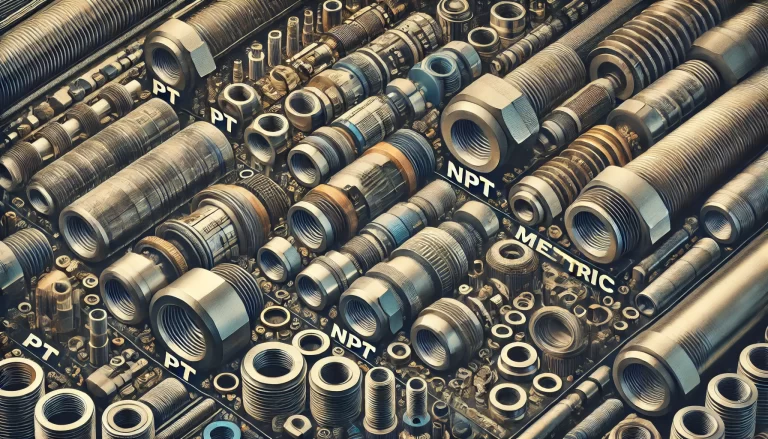
2. NPT Thread (National Pipe Tapered Thread)
NPT (National Pipe Tapered) is the most common thread type used in the United States for pipe fittings. NPT threads are also used in Canada and other countries that follow ANSI/ASME standards.
- Thread Geometry: NPT threads are also tapered, similar to PT threads, but with a different angle and measurement system. The taper helps in creating a better mechanical seal as the pipe is tightened.
- Thread Angle: NPT threads use a 60-degree angle, which differs from the 55-degree angle used in PT threads.
- Seal Mechanism: Like PT threads, NPT threads require Teflon tape or thread sealant for effective sealing, especially for liquid or gas systems. The threads deform slightly as they tighten, providing a good seal for high-pressure applications.
- Application: NPT threads are commonly used in plumbing, gas lines, and industrial piping systems. They are also used in the oil and gas industry.
- Standard: NPT threads adhere to the ANSI/ASME B1.20.1 standard.
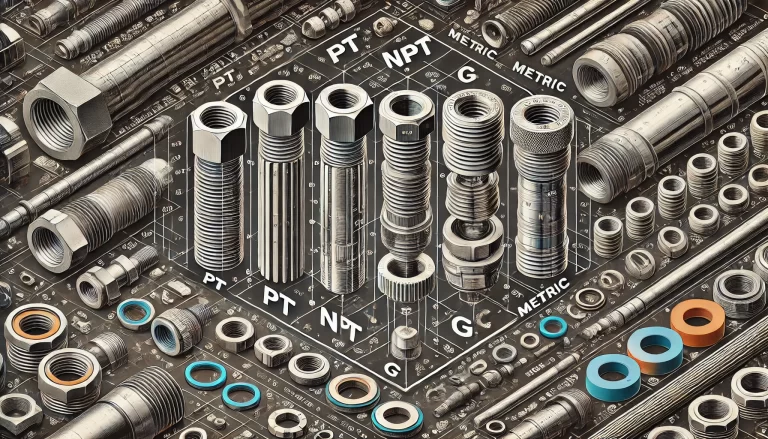
3. G Thread (British Standard Pipe Parallel Thread – BSPP)
G threads belong to the British Standard Pipe Parallel (BSPP) thread family, widely used in the UK, Europe, and many parts of Asia. The G thread is defined under ISO 228, and it is a parallel (non-tapered) thread.
- Thread Geometry: Unlike PT and NPT threads, G threads are parallel, meaning the diameter of the thread remains consistent along its entire length. Since they are parallel, G threads do not inherently form a tight seal when screwed into place.
- Thread Angle: G threads have a 55-degree thread angle.
- Seal Mechanism: Because G threads are parallel, they do not seal via thread deformation. Instead, they require the use of O-rings, washers, or gaskets to create a seal. This design is ideal for applications where a softer seal is needed and where the use of mechanical torque is not ideal.
- Application: G threads are used extensively in low-pressure applications such as water and gas piping. They are common in plumbing fixtures and European hydraulic systems.
- Standard: G threads are specified under the ISO 228-1 standard, also referred to as BSPP (British Standard Pipe Parallel).
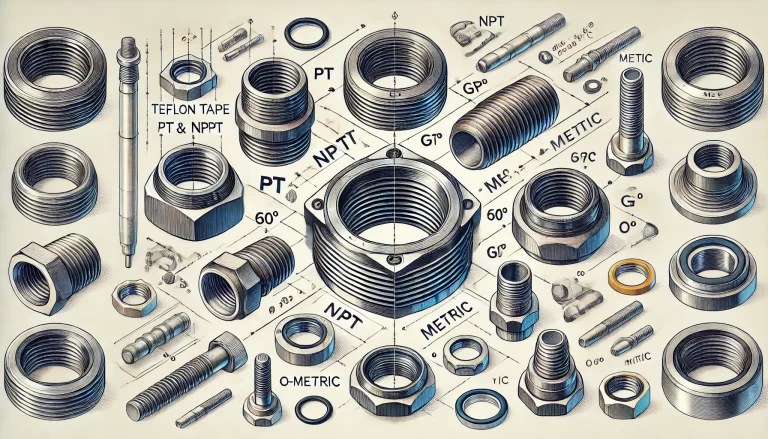
4. Metric Thread (ISO Standard)
Metric threads are the most common type of thread globally, especially in mechanical engineering and automotive industries. These threads conform to the ISO (International Organization for Standardization) metric system, which is based on measurements in millimeters.
- Thread Geometry: Metric threads can be either coarse or fine, with the distance between the threads (pitch) measured in millimeters. They are typically straight or parallel threads, making them easier to manufacture and standardize.
- Thread Angle: The thread angle for metric threads is 60 degrees, which is the same as NPT threads but differs from G and PT threads.
- Seal Mechanism: Metric threads are not designed to create seals in piping applications by themselves. They are typically used in applications where mechanical fasteners (such as screws, bolts, and nuts) are required. When sealing is needed, O-rings or gaskets are used in conjunction with metric threads.
- Application: Metric threads are extremely versatile and are used in everything from bolts and screws to automotive parts, machinery, and electronics. They are most commonly found in European and Asian-manufactured products.
- Standard: Metric threads are governed by the ISO 68-1 standard, which outlines thread pitch and diameter specifications.
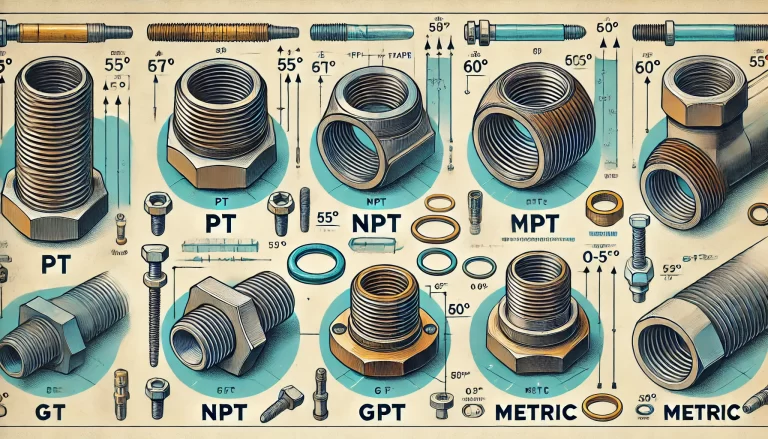
Key Differences Between Thread Types
Taper vs. Parallel:
- PT and NPT threads are tapered, meaning the threads become narrower as they go deeper into the fitting. This taper helps create a tight seal in fluid or gas systems.
- G and Metric threads are typically parallel, meaning they do not narrow. They require the use of a gasket or O-ring to ensure proper sealing.
Thread Angle:
- PT and G threads use a 55-degree angle, while NPT and Metric threads use a 60-degree angle.
Application:
- PT and NPT threads are commonly used for high-pressure piping and fluid systems, where leak-proof connections are critical.
- G threads are more suited for low-pressure applications, like domestic water or gas fittings.
- Metric threads are versatile, being used mostly in mechanical fasteners rather than in piping systems.
Sealing:
- PT and NPT threads seal through the deformation of the threads and often require additional sealing materials like Teflon tape or thread sealant.
- G and Metric threads rely on O-rings, gaskets, or washers to create a seal since the threads themselves are parallel.
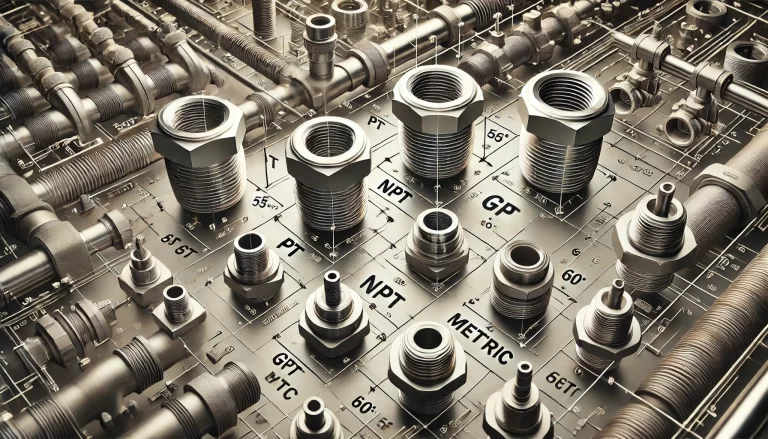
Conclusion
Choosing the right thread type is critical for ensuring the proper function of mechanical assemblies, piping systems, and fluid or gas connections. PT and NPT threads are ideal for high-pressure, leak-proof connections, with NPT threads dominating in the North American market. G threads are more suited for lower-pressure systems where parallel threads and external seals are preferred. Metric threads, being the most common globally, are used in a wide range of industries, particularly in mechanical fastening. Each thread type has its own standards and specific applications, making it important to understand their differences to select the appropriate one for your project.
